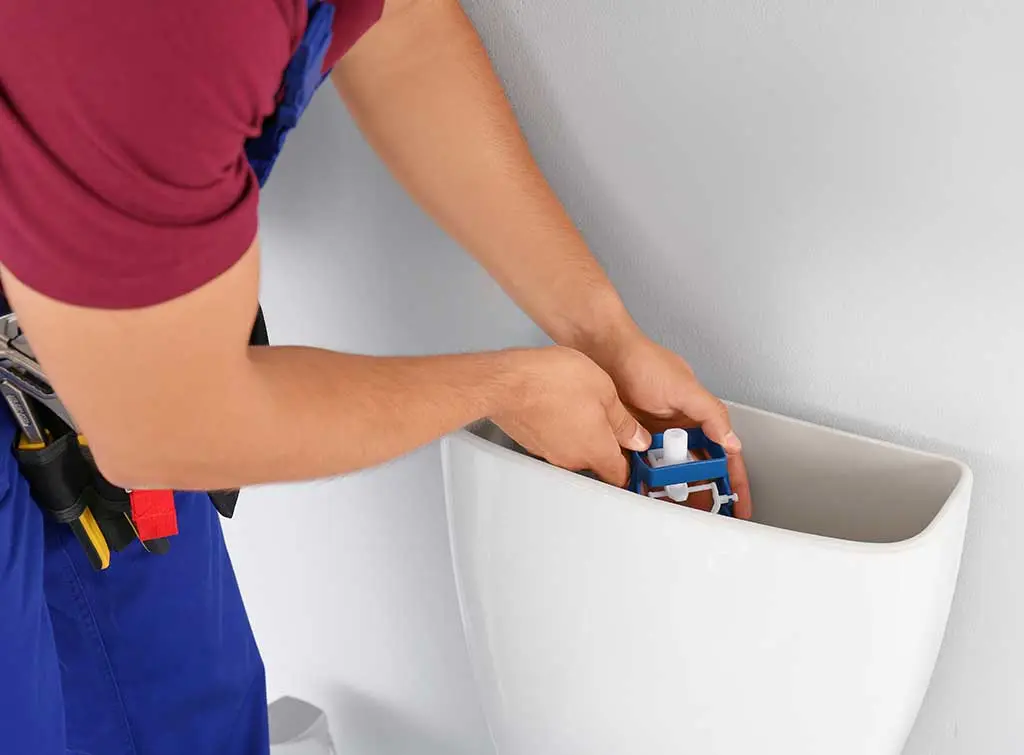Blog>How-To Guides>How to fix a running toilet
Last updated: 21 August 2024
How to fix a running toilet
There's nothing worse than a faulty toilet - especially if you only have one toilet in your home. Don't worry, here we'll show you how to fix a running toilet.

Got a toilet that won't stop running? Not only is this annoying, but it can also lead to water wastage and a hike in your water bill. So, you'll want to find a fix as quickly as possible.
Don't worry. Here, we'll show you how to fix a running toilet so you can get the problem solved once and for all.
But remember: if you're in any doubt about your abilities - or you simply don't have the time, tools or experience needed - it's best to call in a professional. Enter your postcode into the search box below to find a plumber near you.
See the tradespeople we've checked and recommend for your job
Why does my toilet keep running?
If your toilet is constantly running, one of two things is generally happening: water is escaping from your toilet tank, or a component inside your toilet is leaking.
Several different issues could cause these problems. Often, though, it's a leaking flapper, a faulty fill valve, or an overflow pipe that's the wrong size.
Luckily, you won't need to replace your whole toilet. Instead, these things are relatively easy to fix.
So, how do you fix a constantly running toilet? Let's take a look.
How to diagnose and fix a running toilet
Figuring out why your toilet is running isn't always easy. Why? Well, different toilets work differently, depending on their age and type.
For instance, the mechanism on a toilet with a lever handle is different from one with a push-button operation.
Equally, accessing a wall-hung toilet’s concealed cistern will in itself be a challenge, while traditional high-level cisterns (seen in more traditional settings) are different again to the more conventional close-coupled model.
Luckily, there are a few steps you can take that will solve the vast majority of toilet flush problems. Here's how to stop a toilet from running water in just a few steps.
1. Check the fill tube
First things first, let's rule out your toilet's fill tube.
Remove the tank lid and locate the fill tube. This small, bendy tube goes from the fill valve to the toilet overflow tube.
After your toilet flushes, this tube squirts enough water down the toilet overflow tube to refill the bowl while the tank refills. However, if the water misses the overflow tube, the bowl won't fill properly.
With that in mind, make sure that the tube is attached correctly. If it isn't, push it down firmly onto the fill valve and make sure it hovers around an inch above the top of the overflow tube.
2. Check the water level
There are several different approaches to a toilet's flushing mechanism. They all rely on the basic principle of sensing water levels to stop intake, with the valve being stopped by the rising water level.
The most well-known is the ballcock float, which is no longer commonly used in toilets. A similar version is the float cup approach, while other models might use a siphon with an in-built diaphragm to sense water level.
Either way, there should be a fill level mark on the inside back of the tank. Flush your toilet and check whether the water level reaches and stops at that mark.
If it doesn't, try adjusting the water valve to make sure it's fully on, or adjusting the toilet tank float.
How you do this will depend on the age of your toilet - with older toilets, you'll often have to bend a brass rod that connects to the float ball, but with newer toilets, you'll usually just need to turn a screw or slide a clip along a rod.
3. Check the float
While adjusting the float, it's a good idea to check the float itself.
Sometimes, floats can become clogged with water, which can cause your toilet to run.
Unscrew the float and give it a gentle shake to see if you can hear water inside it. If you can, you'll need to replace it.

4. Test the flapper
If your toilet is still running, this could be because the flapper is stuck open.
When the flapper opens, this causes the toilet to flush. But if it can't close properly and completely cover the valve, your toilet will continue to run.
Often, if the chain is too short or tangled, it will prevent the flapper from closing. Use your hand to untangle the chain and adjust the linkage so that there's only a bit of slack when the flapper is closed.
It can also be a good idea to cut off the excess chain at the rod, leaving only around an inch of extra. This can prevent future tangles.
Similarly, if the chain is too long or the flush rod hits the tank lid, the flapper might not open wide enough to complete a whole flush. Put the tank lid back on to check whether the flush rod strikes the lid when you press the lever - if it does, bend it down a little bit and readjust the chain.
5. Flush the toilet
Last but not least, it's time to flush the toilet to find out if your fixes have worked.
Fingers crossed, you've managed to stop your running toilet bowl!
How to repair a leaking toilet if it's still running
If you've followed the above steps and your toilet is still running, the likely culprit is your toilet's fill valve or flapper.
These parts can become defective or worn out, in which case, they'll need replacing.
Alternatively, if you have a modern push-button toilet, it likely relies on a siphon rather than a flapper - this looks like a cylindrical plastic tower.
Siphons are relatively cheap plastic elements and can degrade over time, while washers can incur damage.
It's relatively cost-effective to replace the washer at the bottom of the siphon or the whole unit. However, the tricky part is knowing for sure that your siphon is the problem!
This brings us to...
Find a professional to fix a running toilet in seconds
Although fixing a running toilet might sound simple enough, there are lots of different kinds of toilets and it can be tricky to identify exactly what's going wrong.
So, even the most enthusiastic DIYer can take a significant amount of time. And what if you can't resolve the problem?
Anything with running water can result in a slightly wet disaster, but you’ll likely be left with a toilet with its lid off, an exposed cistern and various bits over the floor. You’ll have wasted several hours and, despite being a have-a-go hero, got no closer to fixing it.
For most people, therefore, a job like fixing a running toilet is best handled by an experienced plumber.
For a start, they’re likely to have plenty of materials in stock to fix any problem - as well as years of experience solving different issues with toilets.
While you get on with other things, they will be able to complete the job of diagnosis and solution much quicker than you can.
In the worst case, they might recommend completely replacing the whole toilet.
The average cost of a plumber is around £50 per hour.
Enter your postcode into the search box below to find a plumber for your job.
See the tradespeople we've checked and recommend for your job
Contact or pay a trade through Checkatrade and you’re covered by our 12-month guarantee of up to £1,000*

See the tradespeople we've checked and recommend for your job


